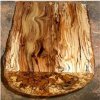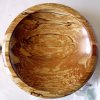Was just invited to cut down and tote away an 8" Holly, so I'll be gassing up the chainsaw Saturday. I've heard that Holly is a fantastic wood to spalt, with colored spalting showing up instead of just dark.
Anyhow, I know the theory is damp, but not touching the ground. There's a spot behind our cabinet shop that stays fairly damp and shaded, would this be a decent place? I'm guessing chock it a few inches off the ground in foot-long logs (sealed ends) and cover it with some sort of tarp. Right? How long? Months?
Anyhow, I know the theory is damp, but not touching the ground. There's a spot behind our cabinet shop that stays fairly damp and shaded, would this be a decent place? I'm guessing chock it a few inches off the ground in foot-long logs (sealed ends) and cover it with some sort of tarp. Right? How long? Months?



